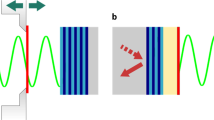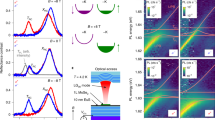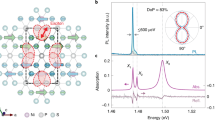Abstract
The interplay between time-reversal symmetry breaking and strong light–matter coupling in two-dimensional (2D) gases brings intriguing aspects to polariton physics. This combination can lead to a polarization/spin-selective light–matter interaction in the strong coupling regime. Here we report such a selective strong light–matter interaction by harnessing a 2D gas in the quantum Hall regime coupled to a microcavity. Specifically, we demonstrate circular-polarization dependence of the vacuum Rabi splitting, as a function of magnetic field and hole density. We provide a quantitative understanding of the phenomenon by modelling the coupling of optical transitions between Landau levels to the microcavity. This method introduces a control tool over the spin degree of freedom in polaritonic semiconductor systems, paving the way for new experimental possibilities in light–matter hybrids.
This is a preview of subscription content, access via your institution
Access options
Access Nature and 54 other Nature Portfolio journals
Get Nature+, our best-value online-access subscription
$29.99 / 30 days
cancel any time
Subscribe to this journal
Receive 12 print issues and online access
$209.00 per year
only $17.42 per issue
Buy this article
- Purchase on Springer Link
- Instant access to full article PDF
Prices may be subject to local taxes which are calculated during checkout




Similar content being viewed by others
Data availability
All of the data that support the findings of this study are reported in the main text, supplementary information and supplementary videos. Source data are available from the corresponding authors on reasonable request.
References
VonKlitzing, K. The quantized Hall effect. Rev. Mod. Phys. 58, 519–531 (1986).
Klitzing, K. V., Dorda, G. & Pepper, M. New method for high-accuracy determination of the fine-structure constant based on quantized Hall resistance. Phys. Rev. Lett. 45, 494–497 (1980).
Stormer, H. L. Two-dimensional electron correlation in high magnetic fields. Phys. B 177, 401–408 (1992).
Kawasugi, Y. et al. Two-dimensional ground-state mapping of a Mott-Hubbard system in a flexible field-effect device. Sci. Adv. 5, eaav7282 (2019).
Li, T. et al. Continuous Mott transition in semiconductor moiré superlattices. Nature 597, 350–354 (2021).
Cao, Y. et al. Unconventional superconductivity in magic-angle graphene superlattices. Nature 556, 43–50 (2018).
Schmeller, A., Eisenstein, J. P., Pfeiffer, L. N. & West, K. W. Evidence for skyrmions and single spin flips in the integer quantized Hall effect. Phys. Rev. Lett. 75, 4290–4293 (1995).
Shukla, S., Shayegan, M., Parihar, S., Lyon, S. & Cooper, N. Large skyrmions in an Al0.13Ga0.87As quantum well. Phys. Rev. B 61, 4469–4472 (2000).
Zuo, Z.-W. et al. Quantum Hall ferromagnets. Rep. Prog. Phys. 72, 086502 (2009).
Bao, C., Tang, P., Sun, D. & Zhou, S. Light-induced emergent phenomena in 2D materials and topological materials. Nat. Rev. Phys. 4, 33–48 (2021).
Smolka, S. et al. Cavity quantum electrodynamics with many-body states of a two-dimensional electron gas. Science 346, 332–335 (2014).
Ravets, S. et al. Polaron polaritons in the integer and fractional quantum Hall regimes. Phys. Rev. Lett. 120, 057401 (2018).
Lupatini, M. et al. Spin reversal of a quantum Hall ferromagnet at a Landau level crossing. Phys. Rev. Lett. 125, 067404 (2020).
Knüppel, P. et al. Nonlinear optics in the fractional quantum Hall regime. Nature 572, 91–94 (2019).
Lyons, T. P. et al. Giant effective Zeeman splitting in a monolayer semiconductor realized by spin-selective strong light–matter coupling. Nat. Photon. 16, 632–636 (2022).
Carusotto, I. & Ciuti, C. Quantum fluids of light. Rev. Mod. Phys. 85, 299–366 (2013).
Whittaker, C. E. et al. Optical analogue of Dresselhaus spin–orbit interaction in photonic graphene. Nat. Photon. 15, 193–196 (2020).
Bloch, J., Cavalleri, A., Galitski, V., Hafezi, M. & Rubio, A. Strongly correlated electron-photon systems. Nature 606, 41–48 (2022).
Hübener, H. et al. Engineering quantum materials with chiral optical cavities. Nat. Mater. 20, 438–442 (2021).
Winkler, R. Spin–Orbit Coupling Effects in Two-Dimensional Electron and Hole Systems, Vol. 191 Springer Tracts in Modern Physics (Springer, 2003).
Ma, M. K. et al. Robust quantum Hall ferromagnetism near a gate-tuned ν = 1 Landau level crossing. Phys. Rev. Lett. 129, 196801 (2022).
Efimkin, D. K. & Macdonald, A. H. Exciton-polarons in doped semiconductors in a strong magnetic field. Phys. Rev. B 97, 235432 (2018).
Rana, F., Koksal, O. & Manolatou, C. Many-body theory of the optical conductivity of excitons and trions in two-dimensional materials. Phys. Rev. B 102, 85304 (2020).
Kavokin, A. V., Baumberg, J. J., Malpuech, G. & Laussy, F. P. Microcavities (Oxford Univ. Press, 2017).
Gianfrate, A. et al. Measurement of the quantum geometric tensor and of the anomalous Hall drift. Nature 578, 381–385 (2020).
Cong, K., Noe, G. T. & Kono, J. Excitons in magnetic fields. Encyclopedia Mod. Opt. 1–5, 63–81 (2018).
Laird, E., Marchetti, F. M., Efimkin, D. K., Parish, M. M. & Levinsen, J. Rydberg exciton-polaritons in a magnetic field. Phys. Rev. B 106, 125407 (2022).
Chervy, T. et al. Accelerating polaritons with external electric and magnetic fields. Phys. Rev. X 10, 011040 (2020).
Liu, X. et al. Strong light–matter coupling in two-dimensional atomic crystals. Nat. Photon. 9, 30–34 (2015).
Graß, T. et al. Optical control over bulk excitations in fractional quantum Hall systems. Phys. Rev. B 98, 155124 (2018).
Graß, T., Cotlet, O., Imamoğlu, A. & Hafezi, M. Optical excitations in compressible and incompressible two-dimensional electron liquids. Phys. Rev. B 101, 155127 (2020).
Cao, B., Grass, T., Solomon, G. & Hafezi, M. Optical flux pump in the quantum Hall regime. Phys. Rev. B 103, L241301 (2021).
Acknowledgements
We thank A. Imamoglu and S. Ravets for valuable discussions and enriching feedback on the paper. This work was supported by grants AFOSR FA9550-20-1-0223, FA9550-19-1-0399, ONR N00014-20-1-2325, NSF IMOD DMR-2019444 and ARL W911NF1920181, M. Martin and the Simons Foundation. P.K. acknowledges financial support from the Swiss National Science Foundation.
Author information
Authors and Affiliations
Contributions
D.G.S.-F. and M.H. conceived and designed the experiments. S.F. and W.W. designed and fabricated the microcavity-QW sample. D.W.S. processed the sample to adapt it for the required measurements. D.G.S.-F. performed the experiments. D.G.S.-F., M.H., M.J.M. and P.K. analysed the data and interpreted the results. D.G.S.-F., M.J.M. and M.H. wrote the paper, with input from all authors.
Corresponding authors
Ethics declarations
Competing interests
The authors declare no competing interests.
Peer review
Peer review information
Nature Photonics thanks Guillaume Malpuech and the other, anonymous, reviewer(s) for their contribution to the peer review of this work.
Additional information
Publisher’s note Springer Nature remains neutral with regard to jurisdictional claims in published maps and institutional affiliations.
Supplementary information
Supplementary Information
Supplementary Figs. 1–4 and Discussion.
Supplementary Video 1
Energy dispersion versus magnetic field for high charge density.
Supplementary Video 2
Energy dispersion versus magnetic field for medium charge density.
Supplementary Video 3
Energy dispersion versus magnetic field for charge neutrality.
Rights and permissions
Springer Nature or its licensor (e.g. a society or other partner) holds exclusive rights to this article under a publishing agreement with the author(s) or other rightsholder(s); author self-archiving of the accepted manuscript version of this article is solely governed by the terms of such publishing agreement and applicable law.
About this article
Cite this article
Suárez-Forero, D.G., Session, D.W., Jalali Mehrabad, M. et al. Spin-selective strong light–matter coupling in a 2D hole gas-microcavity system. Nat. Photon. 17, 912–916 (2023). https://doi.org/10.1038/s41566-023-01248-3
Received:
Accepted:
Published:
Issue Date:
DOI: https://doi.org/10.1038/s41566-023-01248-3
This article is cited by
-
Spin-selective transitions between quantum Hall states
Nature Photonics (2023)



